Intel P965: Mid-Range Performance Sector Roundup
by Gary Key on October 20, 2006 9:00 PM EST- Posted in
- Motherboards
Abit AB9 Pro: Board Layout and Features
Abit designed a board that has one of the more interesting layouts we have seen in a long time. While the board was very easy to install in our mid-size ATX case we did have some issues with utilizing our Optical drive in the top bay due to the location of the JMicron powered IDE port that is located in between the number two PCI Express x1 slot and the number one PCI slot. There are six fan headers on the board that can be controlled by the µGuru Windows utility. The Abit board features an excellent five-phase voltage regulator power design with high quality capacitors located in each major component section of the board that yielded superb stability.

The DIMM module slots' color coordination is correct for dual channel setup based upon the premise of installing DIMMs in the same colored slots for dual-channel operation. The memory modules are easy to install with a full size video card placed in the first PCI Express x16 slot. The 24-pin ATX power connector is located along the edge of the board along with a series of capacitors for the memory modules. Abit places the four-pin 12v auxiliary power connector at the top of the first memory module but completely out of the way of aftermarket cooling solutions we utilized.
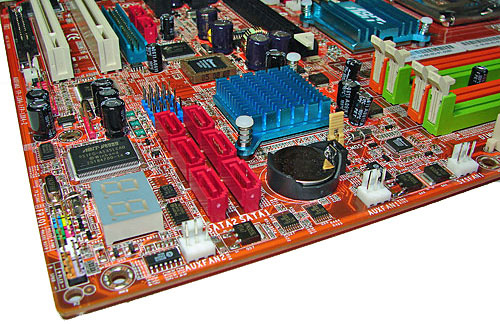
The six Intel ICH8R SATA ports are color coded red and are conveniently located to the left of the ICH8R Southbridge and battery. The SATA ports feature the newer clamp and latch design. We found the positioning of the SATA ports to be excellent when utilizing either the PCI-E x1 or PCI 2.3 slots. The ICH8R is passively cooled and remained cool to the touch throughout testing.
The first three of five auxiliary fan connectors are located at the bottom edge of the board. The clear CMOS jumper is color coded yellow and is located in between the battery and ICH8R chipset. The CP80P post port debug LED, chassis panel, µGuru chipset, and red 1394a connectors are located along the left edge of the board. The blue USB 2.0 connectors are located above the SATA ports.
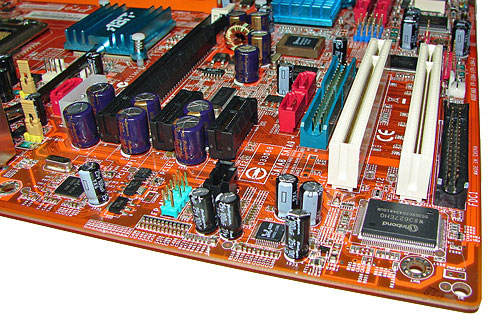
The board comes with (1) physical PCI Express x16 connector, (2) PCI Express x1 connectors, and (2) PCI 2.3 connectors. The layout of this design offers a very good balance of expansion slots for a mainstream board while providing excellent clearance space for graphics card utilization. However, the layout in this area is very unusual if not a bit chaotic. Our main issue is the location of the floppy drive connector at the bottom of the board along with the JMicron JMB363 IDE and SATA ports being sandwiched in between the PCI-E and PCI slots in the middle of the board.
The four-pin Molex power connector that will be required for future GPU products is located above the PCI-E x16 slot along with the Silicon Image 3132 SATA port. Abit informed us some of the unusual port locations were predicated upon ensuring proper power delivery, stability, and trace layouts based upon the capacitor locations. However, we still have to wonder if some of these layout choices were design gaffe that accidentally made it into production.
Returning to the CPU socket area, we find an ample amount of room for alternative cooling solutions. We utilized the stock heatsink/fan in our normal testing but also verified a couple of larger Socket-775 cooling solutions such as the Tuniq Tower 120 would fit in this area during our overclocking tests.
The Intel P965 MCH chipset is passively cooled with a low rise heatsink unit that did not interfere with any installed peripherals. This heatsink is part of the Abit Silent OTES technology that includes a heatpipe system and additional passive cooling for the VRM components. This system kept the MCH cool enough that additional chipset voltage was not a factor in our overclocking tests.
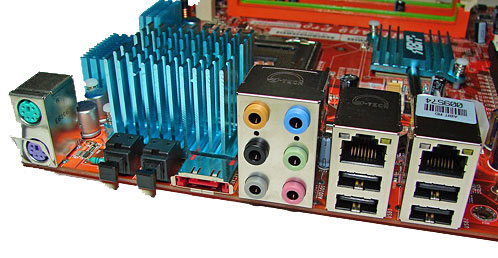
The rear panel contains the standard PS/2 mouse and keyboard ports, LAN ports, and 4 USB ports. The LAN (RJ-45) ports have two LED indicators representing Activity and Speed of the connection through the Realtek RTL8168 Gigabit PCI-E chipset. The audio panel consists of 6 ports that can be configured for 2, 4, 6, and 8-channel audio connections for the Realtek ALC 882D HD codec. The panel also consists of two S/PDIF (optical in/optical out) ports, and an external SATA 3Gb/s port via the Silicon Image 3132 chipset. All in all, Abit included an excellent combination of ports although another two USB ports would have been handy for additional peripherals.
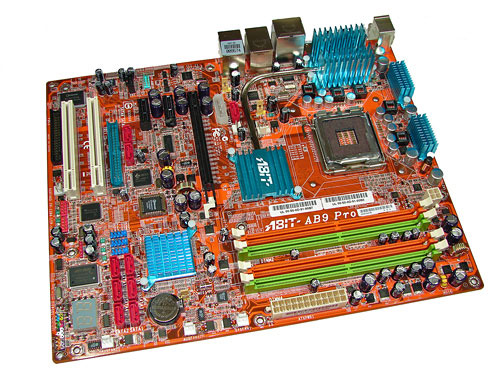 |
| Click to enlarge |
Abit designed a board that has one of the more interesting layouts we have seen in a long time. While the board was very easy to install in our mid-size ATX case we did have some issues with utilizing our Optical drive in the top bay due to the location of the JMicron powered IDE port that is located in between the number two PCI Express x1 slot and the number one PCI slot. There are six fan headers on the board that can be controlled by the µGuru Windows utility. The Abit board features an excellent five-phase voltage regulator power design with high quality capacitors located in each major component section of the board that yielded superb stability.

The DIMM module slots' color coordination is correct for dual channel setup based upon the premise of installing DIMMs in the same colored slots for dual-channel operation. The memory modules are easy to install with a full size video card placed in the first PCI Express x16 slot. The 24-pin ATX power connector is located along the edge of the board along with a series of capacitors for the memory modules. Abit places the four-pin 12v auxiliary power connector at the top of the first memory module but completely out of the way of aftermarket cooling solutions we utilized.

The six Intel ICH8R SATA ports are color coded red and are conveniently located to the left of the ICH8R Southbridge and battery. The SATA ports feature the newer clamp and latch design. We found the positioning of the SATA ports to be excellent when utilizing either the PCI-E x1 or PCI 2.3 slots. The ICH8R is passively cooled and remained cool to the touch throughout testing.
The first three of five auxiliary fan connectors are located at the bottom edge of the board. The clear CMOS jumper is color coded yellow and is located in between the battery and ICH8R chipset. The CP80P post port debug LED, chassis panel, µGuru chipset, and red 1394a connectors are located along the left edge of the board. The blue USB 2.0 connectors are located above the SATA ports.

The board comes with (1) physical PCI Express x16 connector, (2) PCI Express x1 connectors, and (2) PCI 2.3 connectors. The layout of this design offers a very good balance of expansion slots for a mainstream board while providing excellent clearance space for graphics card utilization. However, the layout in this area is very unusual if not a bit chaotic. Our main issue is the location of the floppy drive connector at the bottom of the board along with the JMicron JMB363 IDE and SATA ports being sandwiched in between the PCI-E and PCI slots in the middle of the board.
The four-pin Molex power connector that will be required for future GPU products is located above the PCI-E x16 slot along with the Silicon Image 3132 SATA port. Abit informed us some of the unusual port locations were predicated upon ensuring proper power delivery, stability, and trace layouts based upon the capacitor locations. However, we still have to wonder if some of these layout choices were design gaffe that accidentally made it into production.
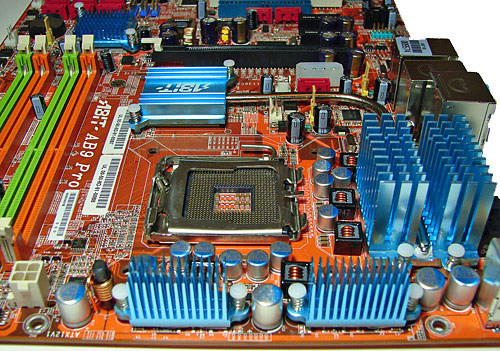 |
| Click to enlarge |
Returning to the CPU socket area, we find an ample amount of room for alternative cooling solutions. We utilized the stock heatsink/fan in our normal testing but also verified a couple of larger Socket-775 cooling solutions such as the Tuniq Tower 120 would fit in this area during our overclocking tests.
The Intel P965 MCH chipset is passively cooled with a low rise heatsink unit that did not interfere with any installed peripherals. This heatsink is part of the Abit Silent OTES technology that includes a heatpipe system and additional passive cooling for the VRM components. This system kept the MCH cool enough that additional chipset voltage was not a factor in our overclocking tests.

The rear panel contains the standard PS/2 mouse and keyboard ports, LAN ports, and 4 USB ports. The LAN (RJ-45) ports have two LED indicators representing Activity and Speed of the connection through the Realtek RTL8168 Gigabit PCI-E chipset. The audio panel consists of 6 ports that can be configured for 2, 4, 6, and 8-channel audio connections for the Realtek ALC 882D HD codec. The panel also consists of two S/PDIF (optical in/optical out) ports, and an external SATA 3Gb/s port via the Silicon Image 3132 chipset. All in all, Abit included an excellent combination of ports although another two USB ports would have been handy for additional peripherals.










62 Comments
View All Comments
powchi - Monday, October 23, 2006 - link
Thanks Jarred, lopri, Aikouka for the reply.Kougar - Saturday, October 21, 2006 - link
I am rather puzzled. As best I can tell from Google, my kit of Corsair TWIN2X2048-6400 does use Micron D9s...... but I use a Gigabyte DS3 and even with the awful release F1 BIOS onwards have had no issues using them. Currently I have a stable OC of 501FSB for a 3.5ghz rating on the old F6 BIOS. Can you confirm if this kit of RAM uses D9's or not, because I am running the 800mhz RAM at 1ghz, 2 or 2.1v only, 5-5-5-15 timings, 24 hour dual Prime stable?? I have a kit of Corsair 6400c4 on the way, so I guess this will prove interesting either way.
I would also like to clarify that with the hours upon hours I spent playing around with and overclocking the DS3, I only once experienced a situation where I had to use the BIOS jumper, as I had managed to lock it into a POST/rebooting cycle. Having only used a Abit IS7 before, I can say it was a major difference I quickly noticed.
Thanks for any info, it's appreciated. And good article, by the way!
Gary Key - Saturday, October 21, 2006 - link
Are your 6400's the 6400 plain or 6400C4? There is a difference between the IC chips used.
We have one set of Micron D9 1GB that work properly in this board but they cost about $650 right now and had a beta SPD. We do not have every D9 1GB module available for testing but the 14 we have tried resulted in failure. Some would do 445, some would do 465. Just about every DS3 owner I know has an issue with the recent D9 1G modules not reaching 500FSB at 1:1 in a stable manner. We even tried three different boards during testing. I was able to hit 510 with the 512MB D9 and some beta 1GB Elpedia sticks from OCZ. Gigabyte agrees with our findings and it should be solved shortly.
We really like the DS3, it proved to be a very stable board in testing. As I stated at the end, this board has changed our opinion about Gigabyte again.
Thanks for the comments. :)
John - Sunday, October 22, 2006 - link
Gary, have you tested G.SKILL 2GB (2 x 1GB) F2-6400PHU2-2GBHZ modules on the DS3? If not please add these to your list. This is some extremely popular Micron D9 memory with favorable reviews on Newegg and our forums.Kougar - Sunday, October 22, 2006 - link
I am currently using the basic 5-5-5-12 1.9v vanilla 6400 kit, not the 6400c3 or the 6400c4. Could you please tell me which of these uses the Micron D9s, since from what you are saying I've only found incorrect info! Thanks for fully explaining this issue with the D9's in your reply, as I did not know Anandtech had tested not one or even two but three DS3's and a whopping 14 modules! So do you know if both the "c3" and "c4" use the Micron D9s, then? I've already ordered the 6400c4 kit, so I am getting the feeling I am in for a rude surprise!
I'm grateful to know that y'all are keeping ontop of the situation, this does go a long way to explaining the extremely large disparity in user results I've read or come across about the DS3. And I'm grateful Gigabyte is working to solve this issue, the user support and countless BIOS work from them is not something I was ever expecting... it's gone a long way to putting them on my top picks list.
And I believe I should be thanking you for the reply. ;)
jonp - Saturday, October 21, 2006 - link
-- on the second memory chart it always says "4/4 slots populated - 1 Dual-Channel Bank". If all four slots are populated with the same memory, why does it say "1" Dual-Channel Bank?-- I can only find the GEIL memory at one on-line merchant (via froogle or pricewatch) at $460 for 2GB. That would be $920 for 4GB! it would have been nice if you had also picked a less expensive memory that more of us could afford.
-- ASUS making a significant change to their product and only changing the version makes it VERY hard (impossible) to on-line order the specific product desired. newegg says order and if wrong, they will exchange...but that gets expensive too... and takes at least 7 days turnaround; and no guarantee that it will be the right one even then.
thanks for the article...it was, as always, full of useful data and observations.
Gary Key - Saturday, October 21, 2006 - link
1. The charts have been corrected. I stated this above but Jarred and I were editing at the same time on some pages and we did an overwrite on each other's corrections a couple of times. We learned our lesson after the Biostar section turned into the ASUS section. ;-)2. When we started this article the GEIL and G.Skill PC2-6400 that we used was in the $269~$289 range for a 2GB kit. This was far below the $500+ prices that our OCZ and Corsair memory modules had reached at that time. I am trying to create a memory table at this time as the boards were tested with everything from A-Data DDR2-533 to OCZ PC2-8000VX2. Our intentions were to use mid-range PC2-6400 memory when we started but it appears we chose some memory that is in very high demand and short supply now.
3. As I stated in the article, ASUS will probably call the 1.02G board something else. The 1.01G board is not a slacker. :)
Thank you for the comments, we appreciate them.
Aikouka - Saturday, October 21, 2006 - link
After going through about 4 or so of the motherboards and looking at their windows programs... I just gotta rant.Why in God's name must motherboard manufacturers make their programs SO UGLY? I'm no Martha Stewart, but even I can see that those programs are attrocious to look at and I actually don't install those cheesy programs because of how horrible they look. I prefer a normal streamlined windows look to my programs, hence why I use the Windows Classic theme. But even if your preference isn't a normal streamlined windows look, I don't see how anyone could find those horrid looking things called applications desirable.
Nakazato - Saturday, October 21, 2006 - link
it's Taiwanese tradition. For the people above... the S3 does not overclock as well as the DS3, it's very noticable. The DQ6 is in theory better than the DS3, but may hardly be noticable and when it is, it's probably just luck of the draw.My only criticism of the review is that only one memory module type was used and that I know other reviews on AT have included some other comparisons... but your review is more recent with more of the facts in(so more relevant). I know you had some references in the article and I know that the Micron chips are the best on average, but on occasion some chips perform better on a per board basis and not just on a per chipset basis.
Review does get 2 thumbs up from me though. The extra side information(EAX2 Support of onboard sound drivers, Micron D9 chips not fully supported, but will be, etc) helps make buying decisions. Thanks for the article!
Aikouka - Sunday, October 22, 2006 - link
Gah, how can such an ugly thing be tradition. It honestly detracts from the overall computing experience having something so tastelessly crafted. I guess to each his own :/